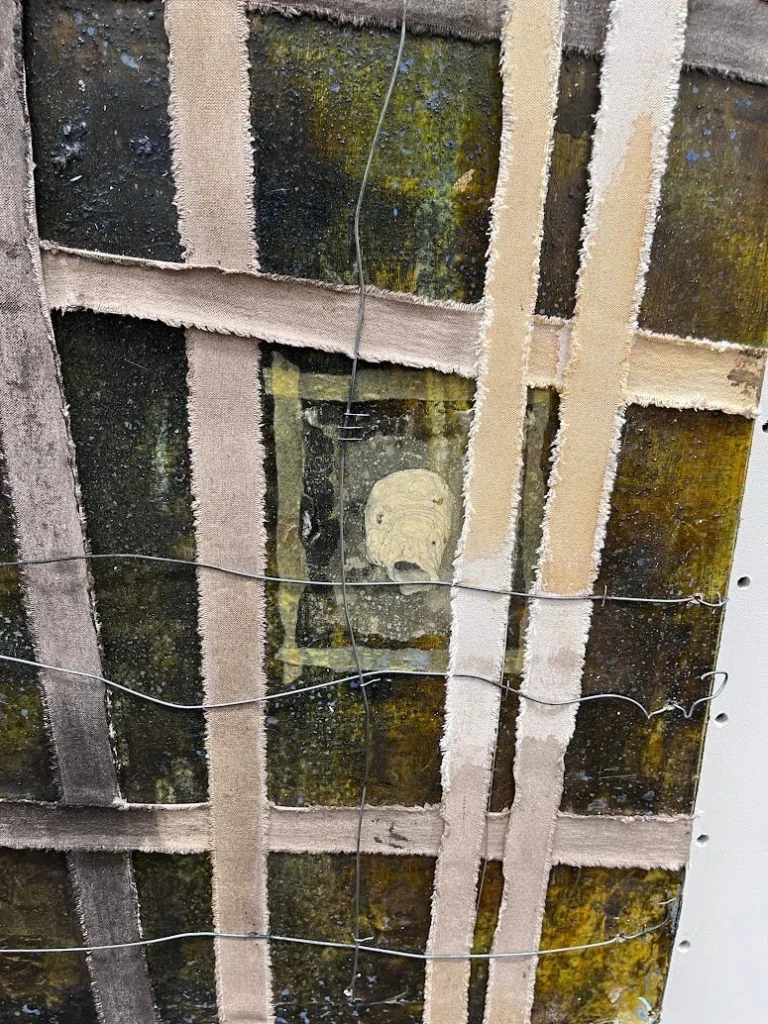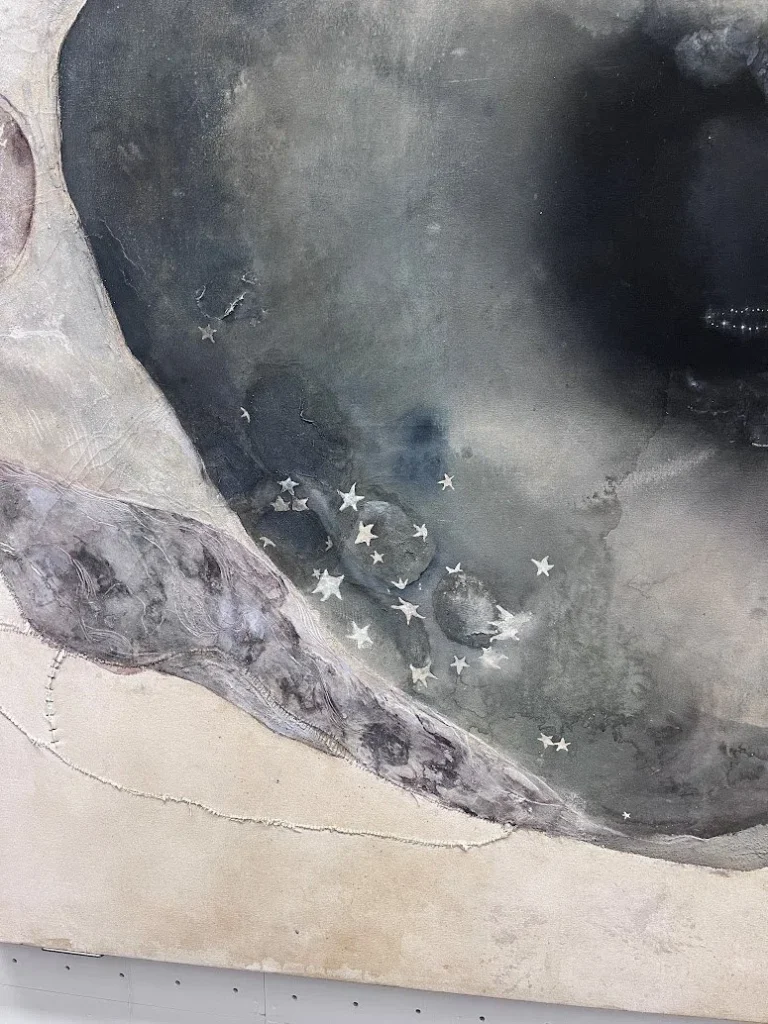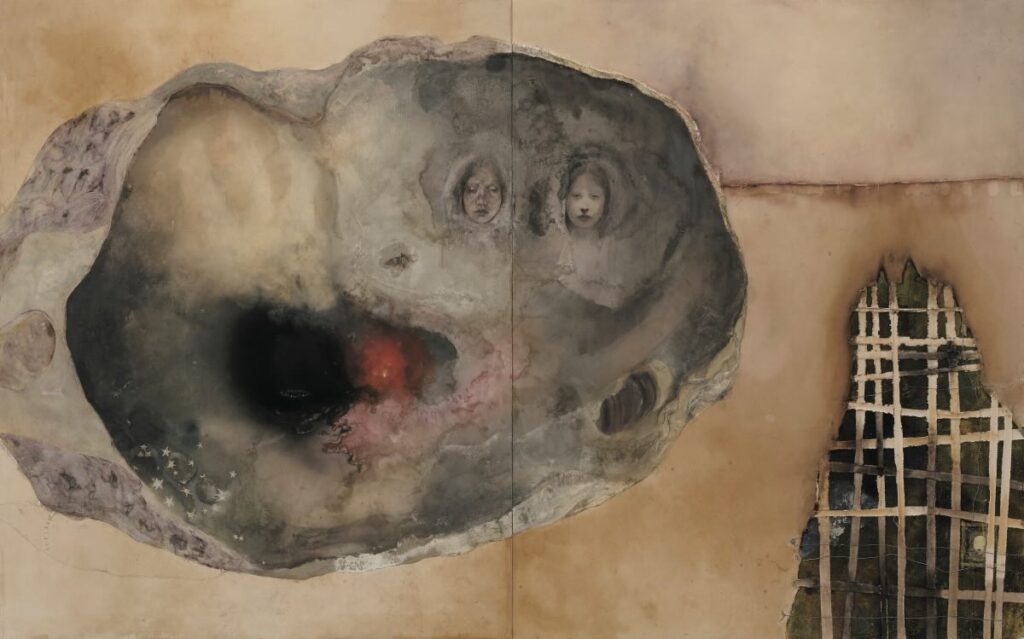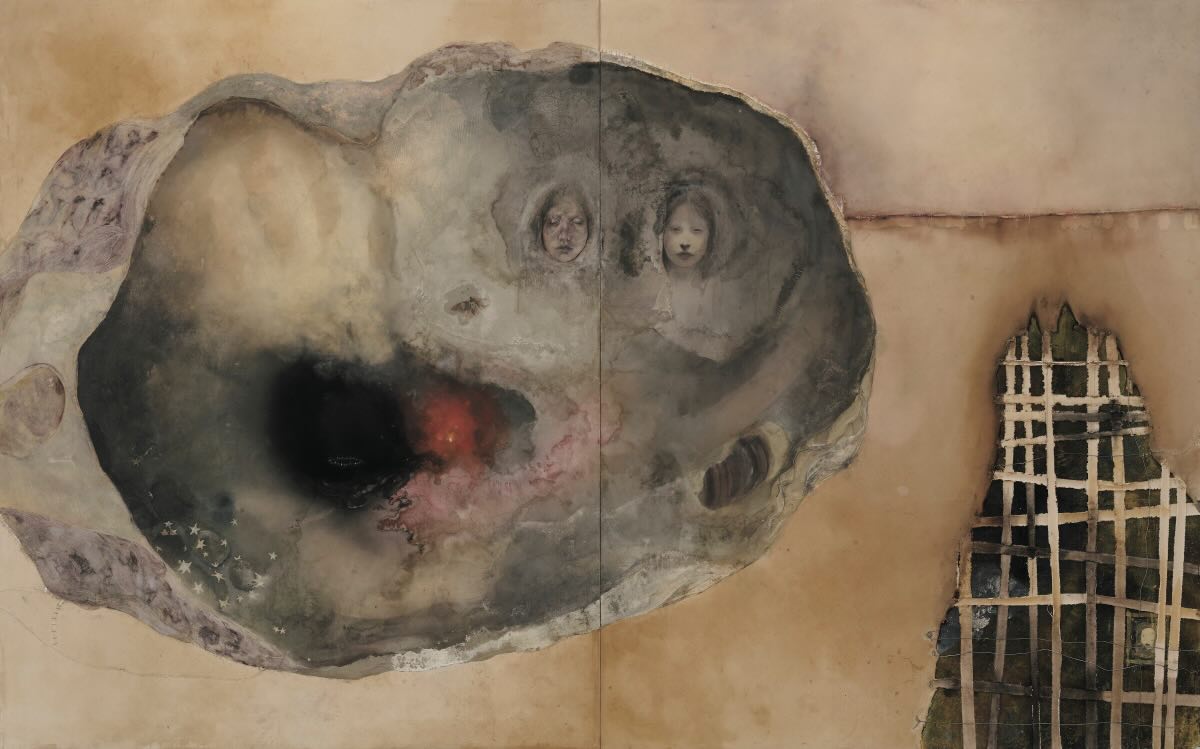A Review by Saito Tsutomu Originally published in Japanese on note.com
Exhibition: Tokyo Selection Exhibition
Institution: Tohoku University of Art & Design
Year: 2024
Medium: Cotton cloth, mineral pigments, water-based pigments, ink, oil varnish, cement, gold leaf
Dimensions: 2500×4000mm
Opening Context
Ishiguro Hikaru’s work was displayed near the exit of the Tokyo Selection Exhibition at Tohoku University of Art & Design. The large-scale painting, despite being a painting, feels monumental like a wall due to its imposing size.
The Work
The lattice structure in the lower right corner of the composition evokes the bamboo framework (komachi) within earthen walls, immediately establishing foreground and background within the pictorial space. The central to left portion of the canvas can be interpreted as an opening or void. This creates multiple layers: the deteriorated earthen wall exists on one dimensional plane, while a hole of an entirely different nature emerges, containing two floating faces and a darker black area positioned slightly below center. These various layers build upon one another, creating a complex spatial narrative.

Symbolism of Life, Death, and Oceanic Memory
The title “Utsuse no Himitsu ha Watashi nomi zo Shiru” begins with the word “utsuse,” which refers to seashells washed ashore on beaches. This evocative term connects directly to Ishiguro’s recurring use of shell motifs throughout her artistic practice. The complete title translates as “Only I know the secret of the seashells,” suggesting a personal, intimate knowledge of these remnants from the sea. Shells, having once sheltered marine life before being carried to shore by waves, represent natural transitions between states of being—from inhabited to empty, from sea to land, from hidden to exposed. This imagery aligns with the painting’s exploration of threshold states and the traces that remain after transformation, establishing the conceptual foundation for understanding the work’s meditation on presence, absence, and the boundaries between visible and invisible worlds.
The two emerging faces likely serve as metaphors for life and death. One face appears with open eyes and pale skin, while the other shows closed eyes with a dimmer, shadowed countenance. Near the closed face, a moth appears—a motif rich with meaning, perhaps representing transformation and rebirth from death. The moth’s presence, combined with the shell-like quality evoked by the title, suggests the cyclical nature of existence and the traces that remain after transformation.
Behind the lattice-like structure lies a vessel on its side, inviting the viewer to peer deeper into the composition’s recesses. The work compels a desire to explore its hidden depths.
Cosmic Depth and Spiritual Resonance
Within the central void, twinkling stars and a golden crown visible in the far distance create a sense of profound depth—or perhaps an abyss. The varied materials—cotton cloth, mineral pigments, water-based pigments, cement—combined with sewn cotton fabric create a surface dense with information, yet maintains a quiet, contemplative dialogue with the viewer.

Viewed as a whole, the composition could also be interpreted as a massive beast with red eyes gazing directly at the observer, creating an unsettling yet mesmerizing presence.
Contemporary Context
Within such threshold spaces, “Utsuse no Himitsu ha Watashi nomi zo Shiru” operates precisely as an exploration of these liminal territories. The boundary between one’s psyche and the surrounding world may never have existed in the first place. Ishiguro’s painting suggests that our perception of separation between internal and external realities is itself an illusion. Through her exploration of Inframince, she creates a visual space where the viewer encounters their own threshold states—between consciousness and unconsciousness, presence and absence, materiality and spirituality.
The work demonstrates Ishiguro’s sophisticated understanding of psychological and spiritual boundaries, enhanced by the poetic resonance of its title referring to seashells cast upon shores—objects that embody the transition between sea and land, life and aftermath. Her works transcend from personal experiences to universal themes, offering sharp insights into modern society through deep inner exploration, with themes questioning existence and absence that overlap with questions many people face today. The shells, moths, and other recurring motifs in her work symbolize the transience and cycle of life beyond the boundaries of material existence.

Artistic Achievement
This work successfully bridges Japanese traditional painting techniques with contemporary conceptual frameworks, creating a dialogue between cultural memory and universal human experience. The piece functions as both a meditation on mortality and a testament to the enduring power of art to reveal hidden dimensions of existence.
Exhibition: Tokyo Selection Exhibition, Tohoku University of Art & Design
Medium: Cotton cloth, mineral pigments, water-based pigments, ink, oil varnish, cement, gold leaf
Year: 2024
Reference:
Okuno Katsumi, Mono mo Ishi mo Shisha mo Ikiteiru Sekai no Min kara Jinruigakusha ga Oshiwareta Koto [What an Anthropologist Learned from People of a World Where Things, Stones, and the Dead Are All Alive], Aki Shobo, 2020.
